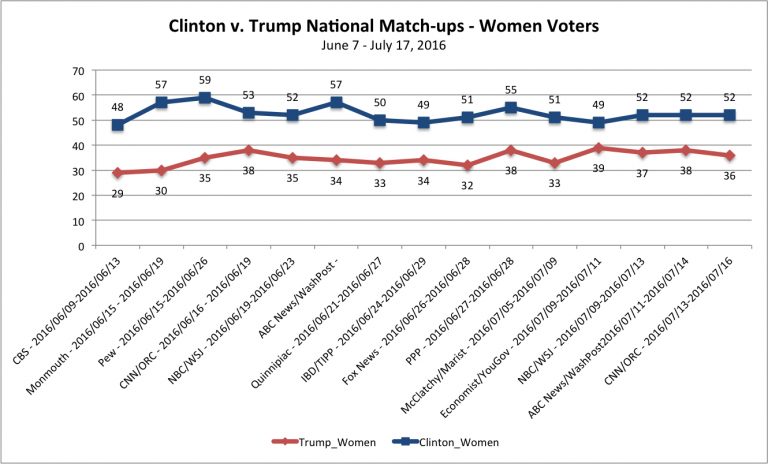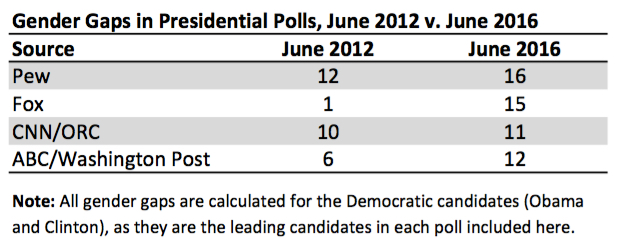Men, Women, and the Gender Gap: Where Trump and Clinton Stand
 In April 2015, the Barbara Lee Family Foundation (BLFF) and the Center for American Women and Politics (CAWP) launched Presidential Gender Watch 2016, a project to track, analyze, and illuminate gender dynamics in the 2016 presidential election. With the help of expert scholars and practitioners, Presidential Gender Watch worked for 21 months to further public understanding of how gender influences candidate strategy, voter engagement and expectations, media coverage, and electoral outcomes in campaigns for the nation’s highest executive office. The blog below was written for Presidential Gender Watch 2016, as part of our collective effort to raise questions, suggest answers, and complicate popular discussions about gender’s role in the presidential race.
In April 2015, the Barbara Lee Family Foundation (BLFF) and the Center for American Women and Politics (CAWP) launched Presidential Gender Watch 2016, a project to track, analyze, and illuminate gender dynamics in the 2016 presidential election. With the help of expert scholars and practitioners, Presidential Gender Watch worked for 21 months to further public understanding of how gender influences candidate strategy, voter engagement and expectations, media coverage, and electoral outcomes in campaigns for the nation’s highest executive office. The blog below was written for Presidential Gender Watch 2016, as part of our collective effort to raise questions, suggest answers, and complicate popular discussions about gender’s role in the presidential race.
In a recent interview with WRKC-Ohio, Donald Trump touted his success in winning over women voters – “Our numbers are starting to get very strong” – and dominating among men – “Our numbers with men are through the roof. I mean, they’re like record-setting numbers.” But how do Trump’s latest poll numbers match up to his claims? How has he fared in recent polls when compared to Hillary Clinton and matched against historical precedent? We took a look at national polls of registered voters since then end of this year’s primaries through this weekend (June 7 – July 17) to check.
Women Voters
First, how are the two presumptive presidential nominees faring with women voters nationally? Across 15 national one-on-one match-up polls, Hillary Clinton averages about 52% of women’s support, while Trump garners 34%, on average, of women’s intended votes. No national poll has Trump winning more than 39% of women’s support. By historical comparison, this poses a problem for Trump. The last time a Republican nominee won less than 40% of women’s votes was in 1996, when Bob Dole earned 38% of women’s support in a three-way race (Perot won 7% of women’s votes). In 2012, Mitt Romney won 44% of women’s votes and Obama secured 55% of women’s support. Of course, both Trump and Clinton have room to improve their performance among women, especially persuading those who remain undecided in current polls.

To better account for undecided, we compared current polls with polls at this time in 2012. Across surveys from four major outlets – Pew, Fox, CNN/ORC, and ABC News/Washington Post, Trump is faring worse with women – between five and eight points lower – than Romney was at this point in the 2012 race. Clinton, on the other hand, is outperforming Obama among women in all polls but one.

Men Voters
If Clinton is faring better with women, perhaps Trump is outperforming his predecessors among men. He is surely leading Clinton among men in national polls, averaging 47% in the past month’s one-on-one match-ups over Clinton’s 39% among male voters. But are these the “record-setting numbers” that Trump claims? Trump’s current support among men is on par with what John McCain won among men on Election Day 2008 (48%), and about five points less than Romney’s proportion of male support in November 2012 (52%). But he does score better than Clinton on this measure; she falls short of Obama’s support among men in his 2012 (45%) and 2008 (49%) wins, and comes closer to John Kerry’s level of male support from 2004 (42%).

Again, though, comparing summer polls to November votes is unfair. When comparing the last month’s polls with polls by the same outlets at this time in 2012, there may be more to learn. For Trump, the claim of “record-setting numbers” with men appears to be false. In all but one outlet’s polls, Trump is faring slightly worse among men than Romney was at this point in the 2012 race. Clinton appears to be about even with Obama’s 2012 support among men in two recent polls, but underperforms among men slightly in the CNN/ORC poll and significantly in the Fox News poll (the same poll in which Trump overperforms by six points).

Gender Gap
Neither candidate can win with women or men alone, but the gender differences in their support may be key to this election’s outcome. The gender gap – the difference between the proportions of women and men who support a given candidate – has been a persistent force in presidential elections since 1980. For over three decades, the gap has illuminated the same trend: Democratic nominees have won more support among women than man, and Republican nominees have fared better among men than women. In 2012, for example, Barack Obama won re-election with a ten-point gender gap; 55% of women and 45% of men cast their ballots for him. Thirty years before him, Ronald Reagan won with a six-point gender gap; 62% of men and 56% of women supported his re-election. Since 1980, the size of the gender gap for the winning presidential candidate has ranged from four to eleven points.

Across the 15 national match-up polls we tracked over the past 5 weeks, the average gender gap is 15 points, four percentage points higher than the average over the past nine elections. The gender gap is also larger in comparison to polls at this time in 2012. While the gender gap in CNN/ORC polls from June 2012 and June 2016 are nearly the same, the gap is four points larger in Pew’s poll and double the 2012 gap in ABC News/Washington Post’s recent 2016 poll. The gender differences in the Fox News polls from 2012 to 2016 are greatest in comparison to other national polls, which may reflect some polling or contextual inconsistencies.
What does this all mean?
These data provide a point-in-time measure of how Trump and Clinton are faring among women and men voters as we enter the party’s nominating conventions. These numbers will likely change over the next five months, but they demonstrate that this election is seeing – at least to date – some of the largest gender differences in vote choice in recent history. Moreover, this data checks candidate claims of success among groups of voters, demonstrating that while Trump’s support among men is on par with Republican nominees before him, his advantage there does not appear enough to counter his larger deficit among women.
Stay Tuned
To monitor gender differences in candidate support through Election Day, follow Presidential Gender Watch’s polling page. We post daily updates of public polls, broken down by gender and reporting the gender gap in each.


